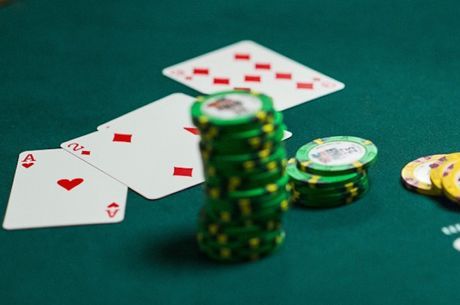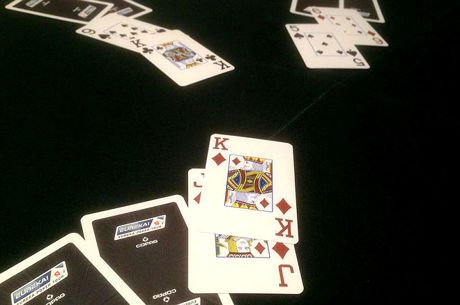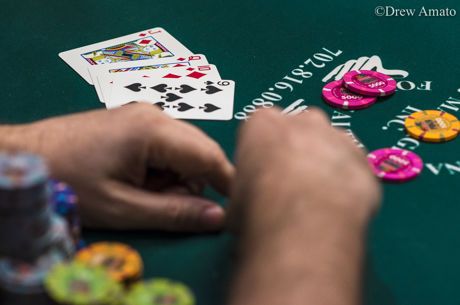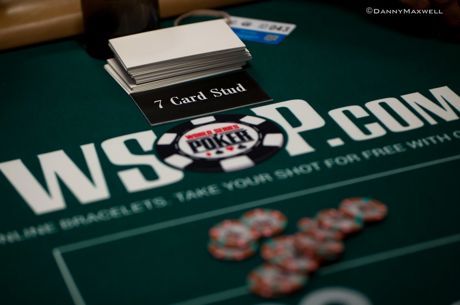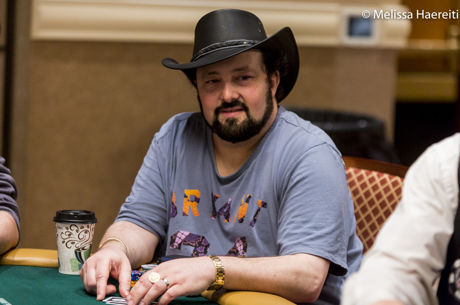Reading Hands in Seven-Card Stud

One of the ways that seven-card stud is different from hold'em is your ability to read the poker hands.
In hold'em, hand reading relies on considering your opponent's betting, his image and the board. There is no need to remember folded cards, nor to consider them when reading your opponent. Similarly, there is no need to consider the individual exposed cards of your opponent, as you share the same board.
That's not the case in seven-card stud. The extra layers of information contained in the folded cards and in your opponent's individual (and developing) board make hand reading much more complicated in stud than in hold'em.
So how do you go about it? Here are five considerations in your stud hand reading:
- Be aware of opponents' exposed card(s) to infer what they are likely and unlikely to have.
- Use opponents' betting in combination with exposed cards to narrow likely ranges of hands.
- Use the other exposed and folded cards to narrow further likely ranges of hands.
- Continue to narrow the range of hands betting actions and the cards that become exposed as the hand progresses.
- Recognize your betting action and your exposed cards may also be used by good opponents to help shape their betting action. They may not be betting just because of the cards they have, but because of what they think you have.
Let's follow this list by walking through a sample stud hand and considering how you might use your hand reading skills to figure out your opponent's hand.
There's a scene early in Rounders when Matt Damon's character watches his law school professor playing poker. At one point in the hand his professor asks him to size up the seven-card stud hand at that moment and share his observations of what each player has.
Damon's character then demonstrates what appears to be savant-like powers of deduction as he calmly goes around the table and tells each player exactly what hand he holds. It seems incredible.
And indeed it is.
No player, no matter how skilled at stud, can accurately divine the exact hand of every player in a stud game. There are just too many possibilities for one to be so precise. However, it is possible — and in fact necessary — to narrow down the possible hands that are likely at that moment based on the betting action, the exposed cards, the folded cards and the general type of player in the hand.
Consider the following hand.
Third Street
You're in a tournament that has reached the 75/150 level with a 25 ante and 25 bring-in. On third street a strong, fairly conventional opponent sitting to your right starts things by raising with the K♠ showing. Imagine that your image is that of a fairly tight and straight-forward player — neither a maniac nor a rock.
Here are the up cards around the table. What hand is he likely to hold?
Seat 1: 6♦
Seat 2: J♦
Seat 3: 3♦ — brings in for 25
Seat 4: K♠ — completes to 100
Seat 5: 7♣ — folds
Seat 6 (You): (A♦A♣) / 4♠
Seat 7: 6♥
Seat 8: A♥
Your first thought should be that he probably has a pair of kings. (When you hear a herd of galloping animals in the Western U.S., think horses, not zebras.) That's the most likely holding for a player raising with an exposed king on third street.
He might have a few other hands as well. He might have a pair of queens — or perhaps some other pair — in the hole, although they would be less likely. A pair of jacks is possible, but one jack is out, making it less likely he is holding two of them. Tens are also possible, but as the value of the pair decreases, so, too, does it become less likely that he would raise, given the A♥ and J♦ that remain.
As this round of betting turns out, you just call with your hidden overpair, the 6♥ folds, the A♥ calls and all of the other players fold.
You need to apply some more hand reading to determine what you think the A♥ has.
You immediately discount two aces as you figure he would almost surely raise if he had them and you also realize how unlikely it is that he holds the case ace in the hole with you already having two aces. Similarly, you figure he would probably raise with a wired pair, representing the aces in an effort to narrow the field and even perhaps win the inflated pot.
You deduce he is on a flush draw headed by that A♥ since there are no more hearts out. But you hold in the back of your mind that he may have a wired pair.
As the hand progresses you will get to see more cards, and you will get to see more betting action from your opponent(s). You must use this additional information to deduce their likely holdings even furuther. It is a huge mistake to put your opponent on a hand early and then tenaciously stick to that opinion even as new information comes in.
Let's continue to consider the hand as it develops. As the cards were dealt on fourth street, you see the following:
Fourth Street
Seat 4: K♠9♣
Seat 6 (You): (A♦A♣) / 4♠5♠
Seat 8: A♥J♥
The ace bets and the king calls. What do you think they have?
You had put the ace on a flush draw. His bet now gives you a moment's pause. He would still be on a flush draw, and his bet might indicate that he has at least a pair as well. Even so, you deduce that he probably is betting a four-flush headed by the ace. Since no hearts have been folded, if he is on a draw he has a better than 50 percent or so chance of making his flush by the river. He could have hit trip jacks with a wired pair of jacks in the hole, but this is unlikely given that a jack has been folded.
Meanwhile you presume that the king still probably holds a split pair of kings. With trip nines or two pair he probably would have raised, you surmise.
You decide to raise. The other players call your raise. This further convinces you that your reads up to this point are probably correct, as if they had stronger hands they would most likely continue to raise.
Let's stop for a second, though, and look more closely at your hand reading logic.
Narrow their range of hands. Start with the ace. As noted, you've ruled out jacks in the hole and a set of jacks, with which he'd have reraised. His call almost surely rules out a low or medium wired pair, as it is unlikely that he would face a double bet with such a modest holding. The fact that he kept calling and did not himself raise narrows him down to most likely holding four hearts, though there is still the thin possibility that he has a pair of queens in the hole and just can't get away from them even with two double bets in this round.
What do you put the king on? Of course just about anything is possible, but what's he likely to have based on his betting action and the exposed cards?
Again, narrowing things down, he is unlikely to be on a three-flush headed by the king, as the fourth card did not improve him and he only called when you raised. Similarly, this action would be very unlikely if he had a wired pair. The only three hands that seem likely for him to have based on how he has bet it and the cards that have been exposed are a pair of kings, two pair (kings and nines), or possibly three nines, with the latter two being significantly less likely than the pair of kings in light of his calling rather than raising your last bet.
Fifth Street
On fifth street the hands progress as follows:
Seat 4: K♠9♣8♥
Seat 6 (You): (A♦A♣) / 4♠5♠5♣
Seat 8: A♥J♥Q♣
You are high on board with your exposed pair of five. You think about checking but decide to bet. Both opponents call. What do you think they have now?
You have to presume that the ace is still on his flush draw. He could be slow playing a set of jacks or queens, but that would be a highly unusual way of playing those hands so you discount it, as he is a fairly conventional player. You think the king is most probably on a pair of kings, perhaps hoping that he is against two flush draws, though you also realize he might have two pair.
Sixth Street
On sixth street the hands progress as follows:
Seat 4: K♠9♣8♥2♦
Seat 6 (You): (A♦A♣) / 4♠5♠5♣8♠
Seat 8: A♥J♥Q♣Q♦
The queens are high and bet. You are not surprised by the bet, though you don't think it means that your opponent has improved to a better hand than yours. Based on your prior reads and the way the hand has developed, you think he is betting with the hope of stealing the pot with a scary board. You still put him on a flush draw, now with a pair of queens to go with it.
The king folds. He is either scared by the paired Queens or perhaps by your third suited card, indicating you may hold a flush. You, thinking you're in the lead, raise, and the pair of queens call, convincing you that you have read the hand correctly.
Seventh Street
On the river you each get a down card.
You: (A♦A♣) / 4♠5♠5♣8♠ / (7♠)
Opponent: (XxXx) / A♥J♥Q♣Q♦ / (Xx)
Your opponent checks. You figure he has a missed flush draw or perhaps some hidden two pair. You bet your aces up and your opponent calls you.
Sure enough you win with your Aces up over his queens up (with the four hearts with which he apparently started).
I'm not suggesting that hand reading is always precise. Players often end up with unexpected and hard-to-read hands. Still, with the application of observation, logic and deduction, you will be able to narrow down the likely hands you face, giving you a decided edge over your less unobservant and not-always-logical opponents.
Ashley Adams has been playing poker for 50 years and writing about it since 2000. He is the author of hundreds of articles and two books, Winning 7-Card Stud (Kensington 2003) and Winning No-Limit Hold'em (Lighthouse 2012). He is also the host of poker radio show House of Cards. See www.houseofcardsradio.com for broadcast times, stations, and podcasts.





